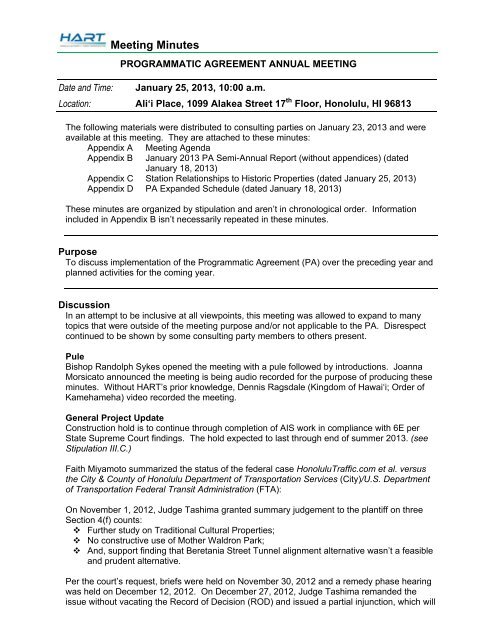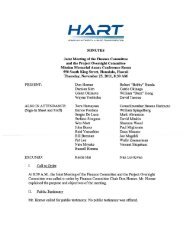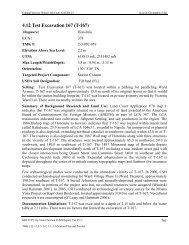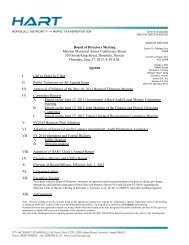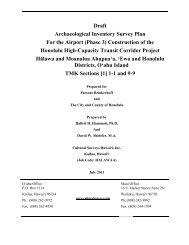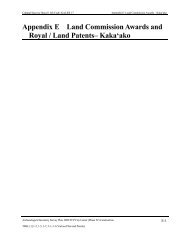January 2013 PA Annual Meeting Minutes - Honolulu Rail Transit ...
January 2013 PA Annual Meeting Minutes - Honolulu Rail Transit ...
January 2013 PA Annual Meeting Minutes - Honolulu Rail Transit ...
Create successful ePaper yourself
Turn your PDF publications into a flip-book with our unique Google optimized e-Paper software.
Date and Time:<br />
<strong>Meeting</strong> <strong>Minutes</strong><br />
PROGRAMMATIC AGREEMENT ANNUAL MEETING<br />
<strong>January</strong> 25, <strong>2013</strong>, 10:00 a.m.<br />
Location: Ali‘i Place, 1099 Alakea Street 17 th Floor, <strong>Honolulu</strong>, HI 96813<br />
The following materials were distributed to consulting parties on <strong>January</strong> 23, <strong>2013</strong> and were<br />
available at this meeting. They are attached to these minutes:<br />
Appendix A <strong>Meeting</strong> Agenda<br />
Appendix B <strong>January</strong> <strong>2013</strong> <strong>PA</strong> Semi-<strong>Annual</strong> Report (without appendices) (dated<br />
<strong>January</strong> 18, <strong>2013</strong>)<br />
Appendix C Station Relationships to Historic Properties (dated <strong>January</strong> 25, <strong>2013</strong>)<br />
Appendix D <strong>PA</strong> Expanded Schedule (dated <strong>January</strong> 18, <strong>2013</strong>)<br />
These minutes are organized by stipulation and aren’t in chronological order. Information<br />
included in Appendix B isn’t necessarily repeated in these minutes.<br />
Purpose<br />
To discuss implementation of the Programmatic Agreement (<strong>PA</strong>) over the preceding year and<br />
planned activities for the coming year.<br />
Discussion<br />
In an attempt to be inclusive at all viewpoints, this meeting was allowed to expand to many<br />
topics that were outside of the meeting purpose and/or not applicable to the <strong>PA</strong>. Disrespect<br />
continued to be shown by some consulting party members to others present.<br />
Pule<br />
Bishop Randolph Sykes opened the meeting with a pule followed by introductions. Joanna<br />
Morsicato announced the meeting is being audio recorded for the purpose of producing these<br />
minutes. Without HART’s prior knowledge, Dennis Ragsdale (Kingdom of Hawaiʻi; Order of<br />
Kamehameha) video recorded the meeting.<br />
General Project Update<br />
Construction hold is to continue through completion of AIS work in compliance with 6E per<br />
State Supreme Court findings. The hold expected to last through end of summer <strong>2013</strong>. (see<br />
Stipulation III.C.)<br />
Faith Miyamoto summarized the status of the federal case <strong>Honolulu</strong>Traffic.com et al. versus<br />
the City & County of <strong>Honolulu</strong> Department of Transportation Services (City)/U.S. Department<br />
of Transportation Federal <strong>Transit</strong> Administration (FTA):<br />
On November 1, 2012, Judge Tashima granted summary judgement to the plantiff on three<br />
Section 4(f) counts:<br />
Further study on Traditional Cultural Properties;<br />
No constructive use of Mother Waldron Park;<br />
And, support finding that Beretania Street Tunnel alignment alternative wasn’t a feasible<br />
and prudent alternative.<br />
Per the court’s request, briefs were held on November 30, 2012 and a remedy phase hearing<br />
was held on December 12, 2012. On December 27, 2012, Judge Tashima remanded the<br />
issue without vacating the Record of Decision (ROD) and issued a partial injunction, which will
<strong>PA</strong> <strong>Annual</strong> <strong>Meeting</strong> <strong>Meeting</strong> <strong>Minutes</strong>—2 <strong>January</strong> 25, <strong>2013</strong><br />
remain in effect for 30-days after FTA notifies that the courts requirements have been fulfilled.<br />
The ruling restrains any construction or real-property acquisition in Section 4 (City Center).<br />
Planning, Engineering, Design and other preconstruction activities including geotechnical<br />
investigations are allowed to proceed. There have been no injunctions on any activities in<br />
Sections 1 (West Oʻahu/Farrington Highway Guideway [WOFH]), Section 2 (Kamehameha<br />
Highway Guideway [ KHG]) and Section 3 (Airport). There is no requirement by the court to<br />
amend the <strong>PA</strong>; the courts decision has no affect on the <strong>PA</strong>.<br />
Betsy Merritt (National Trust for Historic Preservation):<br />
Are you (FTA) going to describe the timetable and procedure for addressing the<br />
additional information the court requests on the three issues?<br />
Will there be the opportunity for public comment on any of the items such as the<br />
TCPs and the Beretania Street Tunnel alternative?<br />
Since all [claims] are Section 4(f) determinations, will these be sent to the<br />
Department of Interior (DOI) for review per the normal Section 4(f) process?<br />
HART is preparing the additional information per the court’s request and anticipates fulfilling<br />
requirements by end of Summer <strong>2013</strong>. HART and FTA will need to discuss with attorneys if<br />
there will be opportunity for public review and comment. FTA will respond to the National<br />
Trust for Historic Preservation’s (NTHP) inquiry if the court’s requested additional information<br />
will be reviewed by DOI.<br />
There are references to Mother Waldron Park and Mother Waldron Playground in numerous<br />
<strong>PA</strong>-related documentation. While both encompass the same area, Mother Waldron<br />
Playground is the historical name of a playground as it existed from 1937 until the early 90’s<br />
when a portion of the playground was demolished to make way for Halekauwila Street.<br />
Certain portions of the original playground were preserved. The Park and the Playground<br />
overlap in location but are two separate resources.<br />
Joanna Morsicato and Lawrence Spurgeon summarized <strong>PA</strong> status by stipulation:<br />
I. Roles and Responsibilities<br />
I.G. (Architectural Historian)<br />
This activity overlaps with Stipulation IX.A.<br />
HART conducted two interviews for the Architectural Historian staff position and is scheduled<br />
to interview another candidate. HART will consider additional applicants and will inform<br />
consulting parties once a selection is made and the candidate accepts. HART continues to<br />
advertise the position. Per Stipulation IX.A, the Architectural Historian shall oversee<br />
stipulations of the <strong>PA</strong> and coordinate Section 106 project activities with SHPD, Kāko‘o, the<br />
Department of Planning and Permitting (DPP) and consulting parties.<br />
Kaleo Paik (Kahu O Kahiko)<br />
Part of the criteria is that the Architectural Historian have firm cultural knowledge<br />
of area. Please outline the criteria listed in the <strong>PA</strong>. Not one cultural resource<br />
person in the lead position has a cultural base, including the military.<br />
Lopaka Asam (Pacific Justice & Reconcilation Center)<br />
Shouldn’t you release the names [of the Architectural Historian] before hand<br />
instead of asking for validation after the fact?
<strong>PA</strong> <strong>Annual</strong> <strong>Meeting</strong> <strong>Meeting</strong> <strong>Minutes</strong>—3 <strong>January</strong> 25, <strong>2013</strong><br />
Criteria for the Architectural Historian position are outlined in the <strong>PA</strong>. The position is a City<br />
civil service position and HART must follow human resource protocol; HART cannot release<br />
the names of any candidates during the process.<br />
I.H. (<strong>PA</strong> Project Manager/Kāko‘o)<br />
Paul Cleghorn (Principal, Pacific Legacy) serves as the Kāko‘o.<br />
Mahelani Cypher (Oʻahu Council, Association of Hawaiian Civic Clubs)<br />
You need to start the Best Practices Manual (BPM) sooner rather than later,<br />
before you start doing other things.<br />
Haʻaheo Guanson (Pacific Justice & Reconcilation Center)<br />
Major concerns are brought forth. What happens to information given at the<br />
kākoʻo meetings?<br />
I.H.12 (BPM /Lessons Learned Case Study)<br />
A outline and definitive schedule for the Best Practices Manual (BPM) will be distributed by<br />
March <strong>2013</strong>.<br />
Betsy Merritt<br />
It was mentioned that the BPM is being expedited in terms of timetable but on the<br />
expanded schedule dated a week ago, the BPM end date is December 2016,<br />
which is the latest date for any item.<br />
Kiersten Faulkner (Historic Hawaiʻi Foundation)<br />
Need to learn from experiences during initial consultation and development of the<br />
<strong>PA</strong>; part of the discussion was can we learn from that experience, document that<br />
and make sure there’s a better relationship, better communication, better<br />
outcomes as a result of that. That’s now 3-4 years ago. Memory is fading and<br />
knowledge is being lost. The Lessons Learned pieces needs to take place really<br />
quickly and include those of us who were a part of it; a lot of people came later<br />
and don’t have the same experience.<br />
Consultation on the implementation of stipulations is ongoing; that’s a separate<br />
chapter with new players. If you break it down in that way, it might help to<br />
address Mahealani’s concern with having it done sooner so that lessons from the<br />
first few years can apply to the next few years.<br />
The BPM and Lessons Learned Case Study are two separate <strong>PA</strong> deliverables; HART will<br />
update expanded schedule to reflect these as two separate items.<br />
The BPM end date on the expanded schedule is based on language in the <strong>PA</strong> (“made<br />
available…within one year of completion of Phase 1 construction”) though a request was<br />
made to have it done earlier. The BPM end date on the schedule will be updated.<br />
New Consulting Parties<br />
Kaleo Paik<br />
The <strong>PA</strong> is a living body that can be amended.<br />
Looking at the introduction to the [<strong>January</strong> <strong>2013</strong> <strong>PA</strong>] Semi-<strong>Annual</strong> Report<br />
(Appendix B) and see who are the CPs, who are the concurring parties and I see<br />
mostly Hawaiian Civic Clubs or benevolent societies but there are hundreds of<br />
Native Hawaiian Organizations (NHOs) than what is currently on the list. Kākoʻo<br />
needs to contact the local DOI office and get the list of registered NHOs.<br />
Haʻaheo Guanson<br />
Neither is Pacific Justice and Reconciliation Center (PJRC) on the list<br />
Kaleo Patterson (Pacific Justice & Reconcilation Center)
<strong>PA</strong> <strong>Annual</strong> <strong>Meeting</strong> <strong>Meeting</strong> <strong>Minutes</strong>—4 <strong>January</strong> 25, <strong>2013</strong><br />
<br />
Lopaka Asam<br />
<br />
<br />
There should be some recognition of the new consulting parties that have come<br />
aboard in the last six months.<br />
My concern is that all of these people fit into your box. Now, you should have a<br />
group of Kanaka Maoli to be involved because it’s our interest at stake. You’re<br />
violating our rights.<br />
Our list are those “outside of the box”.<br />
Consulting parties have a very specific role in the Section 106 process, which leads up to the<br />
development of a memorandum of agreement or <strong>PA</strong>. There is a much larger group of<br />
participants since the [<strong>Honolulu</strong> High-Capacity <strong>Transit</strong> Corridor Project] <strong>PA</strong> was signed [in<br />
<strong>January</strong> 2011]. As stated in the stipulation summary, the list on pages 1-2 of the <strong>PA</strong> include<br />
only those who participated in the development of the <strong>PA</strong>. HART hasn’t and will not exclude<br />
any additional parties who wish to participate. HART will update the list that it uses in<br />
progress reports to include additional parties that have been participating; the list in the <strong>PA</strong><br />
(the <strong>PA</strong> itself) will not be amended.<br />
Additional information not provided at meeting:<br />
The following organizations were recognized at the November 1, 2012 Quarterly <strong>Meeting</strong>, as<br />
noted in those meeting minutes; these organizations will be added to the list used in the <strong>PA</strong><br />
Semi-<strong>Annual</strong> Reports:<br />
Association of Hawaiian Homelands<br />
Pacific Justice and Reconciliation Center<br />
Royal Order of the Crown<br />
Ka Iwi ‘Ōlelo<br />
Kane Hili Hui<br />
Kaleikini ʻOhana<br />
Royal Order of Kamehameha-Moku ‘O Kapuāiwa (Chapter 8)<br />
Council for Native Hawaiian Advancement<br />
Kingdom of Hawai‘i<br />
Order of Kamehameha<br />
II. Traditional Cultural Properties (TCP)<br />
II.A. (Studies to Determine the Presence of Previously Unidentified TCPs)<br />
Kumu Pono Associates and SRI Foundation in coordination with Cultural Surveys Hawaiʻi,<br />
continue to develop the TCP study for City Center. HART expects to review a draft of the City<br />
Center TCP in March/April <strong>2013</strong>.<br />
Mike Lee (Kane Hili Hui)<br />
A TCP Study is never over as far as what can be added for Historical Properties.<br />
I provided information including the chants of Helani, Pahukaina and Hawaiian<br />
maps that never got in to the TCP Study for Section 1.<br />
We’re told it’s never cut off but we’ve never had a meeting to outline our primary<br />
source materials, thus my lawsuit [addendum to <strong>Honolulu</strong>Traffic.com et al. versus<br />
the City/FTA], which involves the Karst Cave System not being included in the<br />
FEIS. I’m pissed off being involved for three years and when it comes to<br />
Hawaiian cultural properties, we are not given an opportunity to meet. The<br />
subsurface is critical just as Roman catacombs. The not identifying of our burial<br />
caves is problematic and is a part of my current federal lawsuit How many<br />
meetings have you had for Hawaiians to identify cultural properties? You need to<br />
schedule a meeting to discuss TCP Study for Phase 1. I want a specific date.<br />
There’s been no take away for the Hawaiian community.
<strong>PA</strong> <strong>Annual</strong> <strong>Meeting</strong> <strong>Meeting</strong> <strong>Minutes</strong>—5 <strong>January</strong> 25, <strong>2013</strong><br />
Ted just said that it’s an ongoing process that we can add to but I really feel that<br />
we’ve been shut out from that process.<br />
HART should hire a Cultural Interpreter; HART archaeologists are not cultural<br />
practitioners.<br />
Haʻaheo Guanson<br />
Concur with Mike; we’ve been asking for a meeting to provide input. Please<br />
provide a meeting date.<br />
A lack of Native Hawaiians on this project is the overall issue. Hire more<br />
Hawaiians.<br />
Hinaleimoana Wong Kalu (Oʻahu Island Burial Council)<br />
Given respect to the other elements of the TCP discussion, quite a while back,<br />
the Native Hawaiian view and perception of what is a TCP was discovered. It<br />
doesn’t coincide with the Federal Guidelines; it’s two very distinct things.<br />
Kaleo Paik<br />
An action item for HART is to have the company [SRIF/Kumu Pono and CSH]<br />
justify why these items [Mike Lee’s information] weren’t included.<br />
Moanalua Stream was not captured in the TCP Study for Sections 1 through 3.<br />
One of the critical components regarding TCP studies is to get input from the<br />
Native Hawaiian community.<br />
Kiersten Faulkner<br />
Will the TCP scope for City Center include cultures in addition to Native<br />
Hawaiian, like Filipino (for Kalihi) and Chinese (for Chinatown)?<br />
Per the <strong>PA</strong>, “evaluate these TCPs…in accordance with guidance in the National<br />
Register Bulletin 38.” It says it’s all cultures.<br />
It’s hard for us to comment on the scope when we don’t know what the scope<br />
covers.<br />
Pua Aiu (State Historic Preservation Division)<br />
The <strong>PA</strong> doesn’t limit it to only Native Hawaiian.<br />
Lopaka Asam with Kaleo Patterson<br />
Show me the title that indicates you have authority and jurisdiction here [in<br />
Hawaiʻi].<br />
Kanaka Maoli are at the top of the totem pole<br />
“I nominate her [Kaleo Paik] to replace you [Joanna Morsicato].”<br />
Kanaloa Koko<br />
It [City Center TCP Study] should be Hawaiians first with the Mahele Study of the<br />
area then the immigration of other cultures. Host-culture should be first and<br />
foremost.<br />
HART will ensure that Moanalua Stream is covered covered in the City Center TCP Study, if<br />
the stream was not already covered in the TCP Study for Sections 1 through 3.<br />
Additional information not provided at meeting:<br />
Moanalua Stream was covered in the TCP Study for Sections 1 through 3.<br />
TCP Study for Sections 1 through 3 is complete and meetings were held. Joanna Morsicato<br />
said that she would check on the scope of work for the City Center TCP Study but didn’t think<br />
it was different than the scope of work for Sections 1 through 3.<br />
Additional information not provided at meeting:<br />
For additional information on the “TCP” process to date, see handout (dated March 6, <strong>2013</strong>)<br />
that was emailed to consulting parties with the February <strong>2013</strong> progress update on <strong>PA</strong><br />
stipulations, and is also available on the project website at www.<strong>Honolulu</strong><strong>Transit</strong>.org/Planning,<br />
under Stipulation II.
<strong>PA</strong> <strong>Annual</strong> <strong>Meeting</strong> <strong>Meeting</strong> <strong>Minutes</strong>—6 <strong>January</strong> 25, <strong>2013</strong><br />
III. Identification and Protection of Archaeological Sites and Burials<br />
III.B (Protocol for Consultation Regarding Treatment of Iwi Kūpuna identified during the<br />
Archaeological Inventory Survey [AIS])<br />
As a result of the AIS (see Stipulation III.C), there were a total of six human skeletal<br />
discoveries including two intact burials (T-142 on Halekauwila St. and Keawe St. and T-227A<br />
at Punchbowl St. and Pohukaina St.) and five fragment finds (T-150 at Halekauwila St. and<br />
Cooke St., T-141 at Halekauwila St. and Keawe St., T-96 in Chinatown, T-170 on Howard<br />
Hughes (private) property, and T-226C at Punchbowl St. and Ala Moana Blvd.). Coordination<br />
regarding treatment of these discovering continues with the State Historic Preservation<br />
Division (SHPD), the Oʻahu Island Burial Council (OIBC) and cultural/lineal descendants.<br />
HART held consultation meetings on November 8, 2012, November 27, 2012, and December<br />
17, 2012. Another consultation will occur on February 7, <strong>2013</strong>. In addition to recognized<br />
lineal and cultural descendants, potential descendants and community members are invited;<br />
HART will not exclude any interested parties from these community meetings.<br />
Betsy Merritt<br />
Two [T-142 and T-227A] of the six listed in the [<strong>January</strong> <strong>2013</strong> <strong>PA</strong> Semi-<strong>Annual</strong>]<br />
report have the status of a “previously identified” burial even though they’re new<br />
discoveries. I’m confused; what’s the implication of that language. Why were<br />
two finds given this status? Does it have to be a completely intact burial to get<br />
this status?<br />
Per Hawaiʻi State Law, by definition, findings are “previously identified” if encountered during<br />
an AIS. Jurisdiction for “previously known” goes to the OIBC whereas jurisdiction for<br />
“inadvertent” goes to SHPD. A find is inadvertent if encountered during construction.<br />
Pua Aiu<br />
A find doesn’t have to be in an intact burial in order to be considered “previously<br />
identified.” The difference here is that certain of these were found in what’s<br />
called a “non-burial context” so they might be found in fill – I think two were found<br />
in fill, so it’s not in a burial context. So, in these cases, where they’re in a nonburial<br />
context, the jurisdiction can go to SHPD. We haven’t made a decision on<br />
this yet.<br />
III.C (Fieldwork)<br />
AIS Reports for WOFH and KHG were approved by SHPD. Airport AIS fieldwork is complete;<br />
47 trenches were surveyed. City Center AIS fieldwork nearing completion; remaining four<br />
trenches of the 28 that were added to the original 232 trenches are scheduled for <strong>January</strong> 26,<br />
<strong>2013</strong>. AIS Reports for Airport and City Center, which summaries fieldwork activities and<br />
findings are in preparation.<br />
Additional information not provided at meeting:<br />
On <strong>January</strong> 26, <strong>2013</strong>, a human pelvis and sacrum were discovered in T-226C at Punchbowl<br />
St. and Ala Moana Blvd., bringing the total discoveries to seven for City Center AIS.<br />
Per the approved AISP for City Center, trench locations represent a number of different<br />
elements of the project:<br />
nearly 100% represent actual/physical column locations while others represent utility<br />
locations as a number of columns will be built where there are existing utilities today<br />
(need to be moved in the future)<br />
station location pillars and<br />
Utility locations/re-locations
<strong>PA</strong> <strong>Annual</strong> <strong>Meeting</strong> <strong>Meeting</strong> <strong>Minutes</strong>—7 <strong>January</strong> 25, <strong>2013</strong><br />
Trenches for TPSS locations<br />
Mahealani Cypher<br />
You have an option of putting the column there and relocating the utility or<br />
relocating the column to where there are no utilities; doesn’t this involve another<br />
survey?<br />
Kaleo Paik<br />
Can PB be more accountable to the staff that they pick for geotechnical-type<br />
work? When I ask the person on-site and he has no idea what a coral shelf is –<br />
that’s scary – because he’s only looking at stratigraphy. As the prime contractor,<br />
PB needs to make sure that it’s subcontractors are looking at things through a<br />
cultural lens, especially in these sensitive areas. It’s difficult if they come from a<br />
foreign place because they don’t understand our geography.<br />
Mike Lee<br />
Addressed concern with 80-foot depth of columns in conjunction with the trench<br />
depth that is being studied and how it further affects ancient TCP like voids that<br />
carry freshwater that’s below [the surface] and that has iwi. You only went to the<br />
alluvial layer.<br />
First Hawaiian Bank Center went through a 6-month delay during construction of<br />
their Corporate Tower because they encountered a void cave, which is a public<br />
trust resources and a Hawaiian cultural property.<br />
I keep on putting it for the record in case there’s future litigation. We’re putting it<br />
on the table because if it’s not, it’s called “inadvertent” under the law. Due care<br />
with due notice in due time is part of what the law looks at; not empty yak. I’m<br />
putting it down for the record because it exists. If you fail to do it then it’s part of<br />
your to do list and if we’re not here to tell you what your to do list is then how do<br />
you know what to do.<br />
Your view is western-focused. That’s your definition of “culture” from a foreign<br />
entity.<br />
The catacombs in Rome are considered archaeological inventory but with us, we<br />
get negated because we’re not the Pope in Rome. Your [Joanna] view is tinted;<br />
it’s a western focus. That’s why I say cultural interpreter. You don’t bother to<br />
find out what our culture is in printed documentation where your researches<br />
didn’t bother to look at because they’re experts and not cultural practitioners.<br />
You excluded a big swath of our people and cut it off when it suits you; that’s not<br />
acceptable and we are here to say that it’s not acceptable.<br />
Lopaka Asam<br />
I have to apologize on behalf of our ancestors that we didn’t anticipate a<br />
choochoo train coming through our bones and I wish you folks would’ve taken<br />
more consideration in the way you designed Punchbowl and show the same care<br />
when that was designed for your dog bones and I wish they would be sent back<br />
to their ancestral homeland because our iwi isn’t there.<br />
HART has the ability to design around the AIS column and utility locations to allow for<br />
preservation in place. HART doesn’t have jurisdiction on determination and treatment. No<br />
additional AIS fieldwork is planned after this weekend.<br />
AIS fieldwork trenching explores cultural layers while geotechnical boring investigates below<br />
the cultural layer. HART has received Mike Lee’s documentation and had already responded<br />
to that request for information. To date, no voids have been encountered during geotechnical<br />
borings or column construction (in the ʻEwa plain).
<strong>PA</strong> <strong>Annual</strong> <strong>Meeting</strong> <strong>Meeting</strong> <strong>Minutes</strong>—8 <strong>January</strong> 25, <strong>2013</strong><br />
HART maintains commitment to being culturally sensitive. Additional coordination with<br />
subcontractors regarding cultural sensitivity has been occurring and will continue.<br />
Geotechnical boring has not yet occurred in City Center.<br />
Cultural Monitoring<br />
Cultural Monitoring is not a requirement of the <strong>PA</strong>. However, HART is voluntarily developing a<br />
project-wide Cultural Monitoring Program to be put in place when construction resumes in Fall<br />
<strong>2013</strong>. Please direct all questions, comments and/or concerns to Joanna Morsicato as she is<br />
facilitating the program development.<br />
HART will continue to work with cultural monitors to ensure that cultural sites are protected<br />
and treated with sensitivity.<br />
IV. Design Standards<br />
Mayor Kirk Caldwell initiated action to create a more aesthetic guideway and stations design;<br />
he is forming a committee. HART expects to be integrated with this initiative to ensure that<br />
historic preservation and cultural issues, amongst others, are discussed.<br />
IV.A Design Language Pattern Book<br />
The Design Language Pattern Book has not and will not be modified. It it being utilized to<br />
guide project design. Hard-copies were recently distributed at the <strong>January</strong> 10, <strong>2013</strong> Project-<br />
Wide Station Design Workshop.<br />
IV.B. Neighborhood Design Workshops<br />
HART held a Project-Wide Station Design Workshop on <strong>January</strong> 10, <strong>2013</strong> and collected a set<br />
of sticky note comments. HART will respond to these comments. See Appendix B (Station<br />
Relationships of Historic Properties), which was a direct outcome of that meeting. Station<br />
Design Workshops will be held in <strong>2013</strong> as design progresses.<br />
Haʻaheo Guanson<br />
It’s my understanding that there will be designers and architects present<br />
It’s not like there going to give a presentation where we can’t provide input, right?<br />
If we’re at 65% design and we have the idea of incorporating a nautilus shellshape,<br />
is it still possible?<br />
Mike Lee<br />
You call people out, raise the level of expectation and then slam it down. You<br />
should set any parameters up front<br />
Clarify boundaries up front. If there are OSHA Laws, City Ordinances, etc. that<br />
precludes “X,” please disclose that in your meeting invitation. People take the<br />
time to let you know how they feel but they don’t know in the weeds what<br />
precludes “X.” So, be specific in the parameters that we can do. There’s a level<br />
of bitterness after when nothing was explained.<br />
Betsy Merritt<br />
The Design Workshop schedule dated October 30, 2012 talks about when<br />
workshops #1 and #2 will occur. Referring to Next Steps page 5 of the current<br />
Semi-<strong>Annual</strong> Report, it states “Station Design Workshops for West Oahu,<br />
Kamehameha Highway and Airport Station Groups – Spring and Summer <strong>2013</strong>.”<br />
Is that Workshop #1 or #2?<br />
HART’s architect and Station Group designers will be present at each workshop and<br />
consulting parties will be able to comment and provide input at these workshops.
<strong>PA</strong> <strong>Annual</strong> <strong>Meeting</strong> <strong>Meeting</strong> <strong>Minutes</strong>—9 <strong>January</strong> 25, <strong>2013</strong><br />
HART is committed to holding two workshops for each station group. Additionally, there will<br />
be workshops for key stations with historic preservation planning considerations (Aloha<br />
Stadium, Pearl Harbor Naval Base, Chinatown and Dowtown Stations) and HART will clarify<br />
how station designers’ staff will support design. Workshop #2 for Farrington Highway Station<br />
Group (West Loch, Waipahu <strong>Transit</strong> Center and Leeward Community College stations) is<br />
planned to occur in February <strong>2013</strong>. Workshop #1 for Kamehameha Highway Station Group<br />
(Pearl Highlands, Pearlridge and Aloha Stadium stations), and Workshop #1 Airport Station<br />
Group (Pearl Harbor Naval Base, <strong>Honolulu</strong> International Airport, Lagoon Drive and Middle<br />
Street <strong>Transit</strong> Center stations) will occur in Spring/Summer <strong>2013</strong>. Workshop #2 for West<br />
Oʻahu Station Group (East Kapolei, UH West Oʻahu and Hoʻopili stations) is scheduled to<br />
occur in Spring/Summer <strong>2013</strong>.<br />
By Workshop #2 for each station group, there are certain elements (structure, elevators, fair<br />
gates, platform length etc.) that cannot be altered. However, there may be ways to<br />
incorporate consulting parties’ design input. For example, the nautilus shell could be<br />
incorporated via floor treatment (tile) if that is concluded to be a recommended design.<br />
IV.C (Preliminary Engineering Design Plans)<br />
Also see Stipulation IV.B<br />
Kiersten Faulkner<br />
Looking at the proposed schedule, you have the design workshops occurring<br />
basically at the same time as final design plans. Per the <strong>PA</strong>, you should be<br />
considering the comments when doing your design plans.<br />
You need to be careful to make time to apply comments to final design; your<br />
schedule doesn’t do that.<br />
What’s the architectural design stage? Architects would normally go with<br />
conceptual, schematic, design development then construction drawings.<br />
You don’t want consulting parties or community members talking about fire exits<br />
or where the outlets are; that’s utterly irrelevant. It needs to be focused on<br />
massing, materials, finistration, site planning, etc.<br />
Final Design Plans listed on the schedule are generally at 60%. Preliminary Engineering<br />
(PE)-level design drawings were developed in 2009 and distributed to consulting parties for<br />
review [on February 25, 2011] and HART received comments from the U.S. Navy, Historic<br />
Hawai‘i Foundation and the Office of Hawaiian Affairs. Those comments and HART’s<br />
responses are also available on the project website]. Those comments have been submitted<br />
to the appropriate designers.<br />
The <strong>Honolulu</strong> <strong>Rail</strong> <strong>Transit</strong> Project is largely being delivered as an engineering project where<br />
even architectural design is following more of an engineering style; the architectural terms<br />
conceptual, schematic, etc. don’t necessarily apply. “Final Design” takes you from 30% to<br />
60% to 90% and finally to 100%. It’s a long period of time with multiple reviews within it.<br />
Station Naming<br />
HART will use a Hawaiian place name as well as a location name for each station. This<br />
activity overlaps with Stipulation VII. HART is forming a Station Naming Committee;<br />
Hinaleimoana Wong-Kalu volunteered to chair this committee. Hina with work with Lisa<br />
Yoshihara, HART’s <strong>Transit</strong> Art Administrator, to create the committee and clarify the process.<br />
Lopaka Asam<br />
We hope it’s [the station names] cultural Hawaiian and not Kaniala, if you know<br />
what I mean.
<strong>PA</strong> <strong>Annual</strong> <strong>Meeting</strong> <strong>Meeting</strong> <strong>Minutes</strong>—10 <strong>January</strong> 25, <strong>2013</strong><br />
Hinaleimoana Wong-Kalu<br />
Joanna has agreed to put my name at the top of the list because there’s no one<br />
else in the room who is as fluent in Hawaiian.<br />
In addition to all other concerns brought forth, OIBC has also put forth concerns.<br />
As the OIBC Chair, I look forward to perhaps maybe a brief sheet of statement in<br />
writing that includes everthing up until now articulating and detailing the project’s<br />
very focused dedication and commitment to some of the cultural things<br />
(language, sub-surface investigations, cultures in addition to Hawaiian, etc.) that<br />
have been brought forth. I have sat at this table for four years now. We’ll wait<br />
with anticipating for that statement.<br />
I look forward to the highlest level of Hawaiian language, landscaping, aesthetics,<br />
etc present and that includes reclaiming our rightful names and rightful places.<br />
The legacy of iwi that has been encountered is our/their history, language and<br />
culture. Don’t prostitute our culture but elevate and further embrace it. Focus on<br />
the Hawaiian first, then the other cultures fall into place. The legacy of the iwi<br />
that serve to guide what happens in the days ahead.<br />
Haʻaheo Guanson<br />
I will serve under you [on the committee].<br />
Kālani Asam<br />
Me too [will serve on the committee].<br />
We’ll start with the “Crapital District”; change it back to “Palace District”, which is<br />
what it was called when I was a Docent at ʻIolani Palace 20-30 years ago.<br />
You need to understand that your box is our coffin.<br />
Kaleo Patterson<br />
I volunteer too [to serve on the committee].<br />
Kaleo Paik<br />
And, Hina can pick and choose who [serves on the committee].<br />
Re-internment Sites<br />
No significant discussion took place<br />
<strong>PA</strong> stipulations V through XIV received abbreviated discussion. See Appendix B for<br />
details per stipulation. Several items are noted below.<br />
V. Recordation and Documentation<br />
V.A. Historic Context Study (HCS)<br />
No update<br />
V.B. Cultural Landscape Reports (CLR)<br />
No update<br />
V.C. Historic American Building Survey (HABS), Historic American Engineering Record<br />
(HAER), and Historic American Landscape Survey (HALS) (HHH) Recordation<br />
The <strong>PA</strong> requires HHH documentation to be completed prior to construction in particular area.<br />
Honouliuli Bridge final HAER awaiting submission to National Park Service (NPS) in<br />
coordination with the State Department of Transportation.<br />
Hard-copies of the Waikele Canal Bridge and Highway Overpass, Waimalu Bridge, Kalauao<br />
Springs Bridge and Kalauao Stream Bridge HAERs – in final form – were available for review
<strong>PA</strong> <strong>Annual</strong> <strong>Meeting</strong> <strong>Meeting</strong> <strong>Minutes</strong>—11 <strong>January</strong> 25, <strong>2013</strong><br />
at this meeting. These HAERs were submitted to the the National Park Service (NPS). They<br />
will be uploaded to the project website and to the Historic Properties Database (see<br />
Stipulation VI.F).<br />
V.E (Digital Photography)<br />
Digital Photography for all adversely affected properties on historic resources along the<br />
corridor is complete and will be transmitted to SHPD and City Muncipal Library on CD, and<br />
uploaded to the historic properties database.<br />
VI. National Register of Historic Places/National Historic Landmark Nominations<br />
There is not a specific time frame for completion of National Register (NR) nominations other<br />
than before revenue service – except for sites in proximity to Pearl Harbor. Honouliuli Bridge<br />
final NR nomination will be submitted to NPS.<br />
VI.F (Searchable Database of Historic Properties)<br />
A demonstration of the Historic Properties Database (http://historichonolulutransit.org) was<br />
given prior to the meeting for those individuals that arrived early. The database will be<br />
populated as additional recordation and documentation is finalized and approved; information<br />
will be uploaded under the corresponding property.<br />
VII. Educational and Interpretive Programs, Materials and Signage<br />
VII.E. Educational Program<br />
HART mailed approximately 3,600 postcards inviting owners of potentially eligible properties<br />
in the APE and within a 2,000-foot radius of station locations to the first of two Historic<br />
Preservation Educational Workshops, which will occur on February 12, <strong>2013</strong> in conjunction<br />
with the the Historic Preservation Fund (HPF) Program noted in Stipulation IX.B.<br />
VIII. Mitigation for Specific Historic Properties<br />
No activity to report.<br />
IX. Measures to Address Reasonably Foreseeable Indirect and Cumulative Effects Caused<br />
by the Project<br />
<strong>Transit</strong>-Oriented Development (TOD)<br />
The City Department of Planning & Permitting’s Ala Moana Neighborhood TOD Workshop #2<br />
will occur on February 19, <strong>2013</strong>.<br />
IX.B (Historic Preservation Committee [HPC])<br />
In <strong>January</strong> <strong>2013</strong>, HART mailed HPF Program letters and applications to 159 owners of eligible<br />
properties adjacent to the project or in historic districts adjacent to the alignment with an<br />
invitation to the Historic Preservation Educational Workshop noted in Stipulation VII.E. The<br />
HPC next meets on February 19, <strong>2013</strong>. HPF applications due by March 15, <strong>2013</strong>.<br />
X. Construction Protection Plan<br />
Construction on hold; no activity to report.<br />
XI. City Contractors and Contract Adherence to <strong>PA</strong><br />
See Appendix B for stations that require a Historic Architect.
<strong>PA</strong> <strong>Annual</strong> <strong>Meeting</strong> <strong>Meeting</strong> <strong>Minutes</strong>—12 <strong>January</strong> 25, <strong>2013</strong><br />
XII. Post-Review Discoveries<br />
No activity to report.<br />
XIII. Public Information<br />
See Stipulation XIV.<br />
XIV. Administrative Provisions<br />
XIV.A (Implementation Schedule)<br />
The <strong>PA</strong> Expanded Schedule is attached to these minutes as Appendix D. The schedule is an<br />
interactive process and is not set-in-stone. Please advise HART if anything needs to revised<br />
or added.<br />
XIV.E (Monitoring and Reporting)<br />
Consulting parties expressed difficulty with navigating for information. Consulting parties have<br />
no objection in continuing to receive emails from Joanna Morsicato as opposed to eBlasts.<br />
HART will accommodate those without access to a computer with a hard-copy available for<br />
viewing at HART’s offices.<br />
Mahelani Cypher<br />
There should be resource people available to answer our questions here and<br />
now. You need to anticipate certain questions.<br />
Lopaka Asam<br />
I don’t mind having a paper trail because I’m computer illiterate.<br />
I’m afraid about giving my address because I don’t want to be hit with a bullet<br />
when I come out of my door. That’s why I left my number.<br />
Umi Sexton<br />
There needs to mailout for those who don’t have access to internet.<br />
Mike Lee<br />
Nothing is heard. There’s no eBlast or meeting minutes to make us feel warm<br />
and fuzzy that we’ve brought these things to the table. Nobody out there ever<br />
knows what was discussed. The priorities were never listed and blasted out to<br />
the stakeholders. We put it on the table year after year. You don’t come back<br />
with a specific date to follow-up on items we’ve requested.<br />
XIV.E.2 (Quarterly <strong>Meeting</strong>s)<br />
This meeting functions as the first <strong>Annual</strong> <strong>Meeting</strong> of <strong>2013</strong> and also as the first Quarterly<br />
<strong>Meeting</strong> of <strong>2013</strong>. The next Quarterly <strong>Meeting</strong>w will occur in April <strong>2013</strong> and HART will<br />
continue to hold Quarterly or Ad Hoc <strong>Meeting</strong>s to address active <strong>PA</strong> topics and to have a<br />
more focused discussion for items like Station Naming, Educational and Interpretive Programs<br />
and Signage, and Reinternment Sites.<br />
Hinaleimoana Wong Kalu<br />
For those of us who have been at this table for quite some time now, there’s a<br />
divergence that’s quite clear. To mitigate the concerns, especially those brought<br />
forth by the Kanaka Maoli, perhaps you may have a more directly centered<br />
meeting.<br />
The discussion that have occurred here are quite distinct. There are other<br />
elements that you are required to do. In terms of your direct outreach to the<br />
Hawaiian community, but I think a Hawaiian directed/focused meeting is<br />
adviseable because it would allow (1) for those of us who represent Hawaiian
<strong>PA</strong> <strong>Annual</strong> <strong>Meeting</strong> <strong>Meeting</strong> <strong>Minutes</strong>—13 <strong>January</strong> 25, <strong>2013</strong><br />
<br />
<br />
views, we have a chance to say this is what the OIBC has come through and (2)<br />
allow other Hawaiian voices to say what they’ve wanted to say and the project<br />
respond by illustrating and demonstrating how the project will serve the Native<br />
Hawaiian community in honoring our culture, history and language?<br />
That’s a reasonable and prudent request.<br />
Let’s say everyone from top to bottom on this project were Hawaiian and this<br />
were a Native Hawaiian Organization, would we be any different? What I fear is<br />
that I could come to this table and say some of the things that I have used to say.<br />
What I fear is that if we didn’t just start to say these things.<br />
XIV.E.3 (Semi-<strong>Annual</strong> Report)<br />
The <strong>January</strong> <strong>2013</strong> <strong>PA</strong> Semi-<strong>Annual</strong> Report for the period of July 19, 2012 through <strong>January</strong> 18,<br />
<strong>2013</strong> is available on the project website.<br />
XIV.E.4 (FTA’s Evaluation of <strong>PA</strong>)<br />
At this time, FTA feels that no amendments or changes to the <strong>PA</strong> are needed.<br />
Communication and disseminating of information has improved and continues to be refined.<br />
Adjournment<br />
Umi Sexton who deferred an opportunity to perform the opening pule to Bishop Sykes,<br />
performed the closing pule. Bishop Sykes had left before the meeting ended.<br />
Kaleo Paik<br />
If we’re going to do a general prayer from a Western standpoint, I have no<br />
problem with that. But, if we’re doing pule from a cultural standpoint, the person<br />
who performs the opening pule must perform the closing pule. You’re opening<br />
up portals and they need to be closed.<br />
*** <strong>Meeting</strong> adjourned at 12:40pm ***<br />
Action Items<br />
HART to staff Architectural Historian position<br />
HART/FTA to discuss with attorneys if opportunity for public review/comment of<br />
the additional information on the three Section 4(f) claims; respond to NTHP<br />
inquiry<br />
HART to distribute BPM Outline and Definitive Schedule by March <strong>2013</strong><br />
Kākoʻo to contact the local DOI office to get list of NHOs for information<br />
Schdedule meeting with Mike Lee et al to discuss TCP Study for Sections 1<br />
through 3; namely Section 1 (WOFH); justify why not all of the information<br />
submitted by Mike Lee weren’t included<br />
Draft CC TCP Study by March/April <strong>2013</strong>; clarify scope of work<br />
Update Expanded Schedule:<br />
o List BPM and Lessons Learned Case Study as two separate items<br />
o Update BPM end date<br />
Upload final HAERs to project website and Historic Properties database<br />
Update consulting parties list used in <strong>PA</strong> Semi-<strong>Annual</strong> Reports<br />
Schedule a directly centered meeting with Hawaiians<br />
Attending Consulting Parties<br />
Betsy Merritt<br />
Clare Apana<br />
David Nakino<br />
National Trust for Historic Preservation<br />
Malama Kakanilua; Kane Hili Hui<br />
Pacific Justice and Reconciliation Center (PJRC)
<strong>PA</strong> <strong>Annual</strong> <strong>Meeting</strong> <strong>Meeting</strong> <strong>Minutes</strong>—14 <strong>January</strong> 25, <strong>2013</strong><br />
Dawn Hegger<br />
Dennis Ragsdale<br />
Ha‘aheo Guanson<br />
Hinaleimoana Wong-Kalu<br />
Jean Rasor<br />
Jeff Dodge<br />
Gov. John Waiheʻe<br />
Kālani Asam<br />
Kaleo Paik<br />
Kanaloa Koko<br />
Kiersten Faulkner<br />
Laʻakea Suganuma<br />
Mahealani Cypher<br />
Mike Lee<br />
Randolph Sykes<br />
Robert “Lopaka” Asam<br />
Paulette “Ka‘anohi” Kaleikini<br />
Pua Aiu<br />
Susan Lebo<br />
Tanya Gumarac-McGuire<br />
Umi Sexton<br />
Dial-In Consulting Parties<br />
Blythe Semmer<br />
Ellyn Goldkind<br />
Jerry Norris<br />
Ted Matley<br />
Attending Project Staff<br />
Anna Mallon<br />
Bruce Nagao<br />
Faith Miyamoto<br />
Joanna Morsicato<br />
Kaleo Patterson<br />
Barbara Gilliland<br />
Gary Omori<br />
Josh Silva<br />
Lawrence Spurgeon<br />
Matt Derby<br />
Pat Lee<br />
Paul Cleghorn<br />
Robert ʻAukai Reynolds<br />
Roland Bueno<br />
Hawaiʻi Community Development Authority<br />
Kingdom of Hawai‘i; Order of Kamehameha<br />
PJRC<br />
O‘ahu Island Burial Council (OIBC)<br />
Kahu O Kahiko, Inc.<br />
NAVFAC HI, Navy Region Hawai‘i<br />
PJRC<br />
PJRC<br />
Kahu O Kahiko, Inc.<br />
Royal Order of the Crown; Ka Iwi ‘Ōlelo<br />
Historic Hawai‘i Foundation (HHF)<br />
Royal Hawaiian Academy of Traditional Arts<br />
O‘ahu Council, Association of Hawaiian Civic Clubs<br />
Kane Hili Hui<br />
PJRC; Interfaith Alliance Hawaii; Inclusive Orthodox Church;<br />
Oahu Metropolitan Planning Organization<br />
PJRC<br />
State Historic Preservation Division (SHPD)<br />
SHPD<br />
HHF<br />
Kingdom of Hawai‘i; Order of Kamehameha<br />
Advisory Council on Historic Preservation<br />
NAVFAC HI, Navy Region Hawai‘i<br />
Office of Hawaiian Affairs<br />
Federal <strong>Transit</strong> Administration-Region IX<br />
<strong>Honolulu</strong> Authority for Rapid Transportation (HART)<br />
HART<br />
HART<br />
HART<br />
HART; PJRC<br />
Parsons Brinckerhoff (PB)<br />
PB<br />
PB<br />
PB<br />
PB<br />
PB<br />
Pacific Legacy, Inc.<br />
HART<br />
HART
<strong>PA</strong> <strong>Annual</strong> <strong>Meeting</strong> <strong>Meeting</strong> <strong>Minutes</strong>—15 <strong>January</strong> 25, <strong>2013</strong><br />
Appendix A<br />
<strong>Meeting</strong> Agenda
<strong>PA</strong> <strong>Annual</strong> <strong>Meeting</strong> <strong>Meeting</strong> <strong>Minutes</strong>—16 <strong>January</strong> 25, <strong>2013</strong><br />
Appendix B<br />
<strong>January</strong> <strong>2013</strong> <strong>PA</strong> Semi-<strong>Annual</strong> Report<br />
(without appendices)<br />
(dated <strong>January</strong> 18, <strong>2013</strong>)
<strong>PA</strong> <strong>Annual</strong> <strong>Meeting</strong> <strong>Meeting</strong> <strong>Minutes</strong>—17 <strong>January</strong> 25, <strong>2013</strong><br />
Appendix C<br />
Station Relationships of Historic Properties<br />
(dated <strong>January</strong> 25, <strong>2013</strong>)
<strong>PA</strong> <strong>Annual</strong> <strong>Meeting</strong> <strong>Meeting</strong> <strong>Minutes</strong>—18 <strong>January</strong> 25, <strong>2013</strong><br />
Appendix D<br />
<strong>PA</strong> Expanded Schedule<br />
(dated <strong>January</strong> 18, <strong>2013</strong>)


